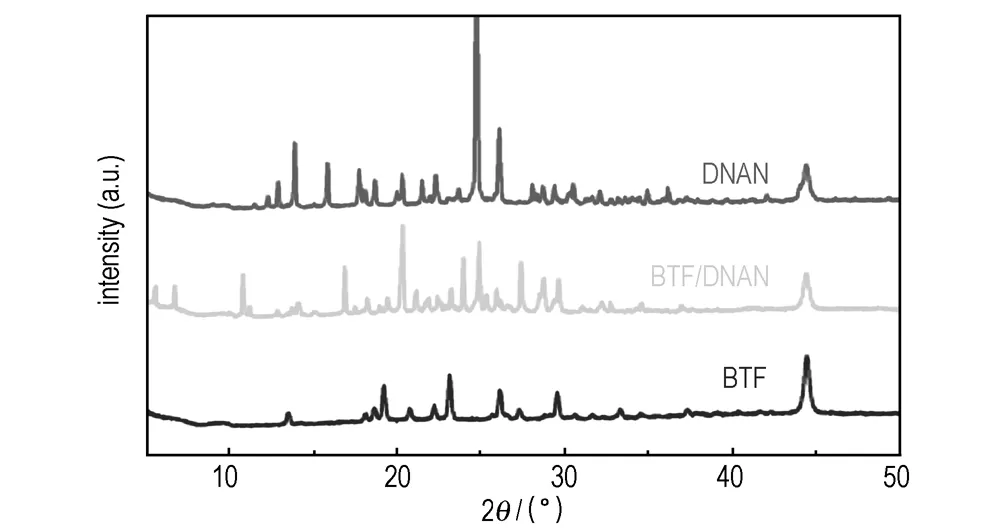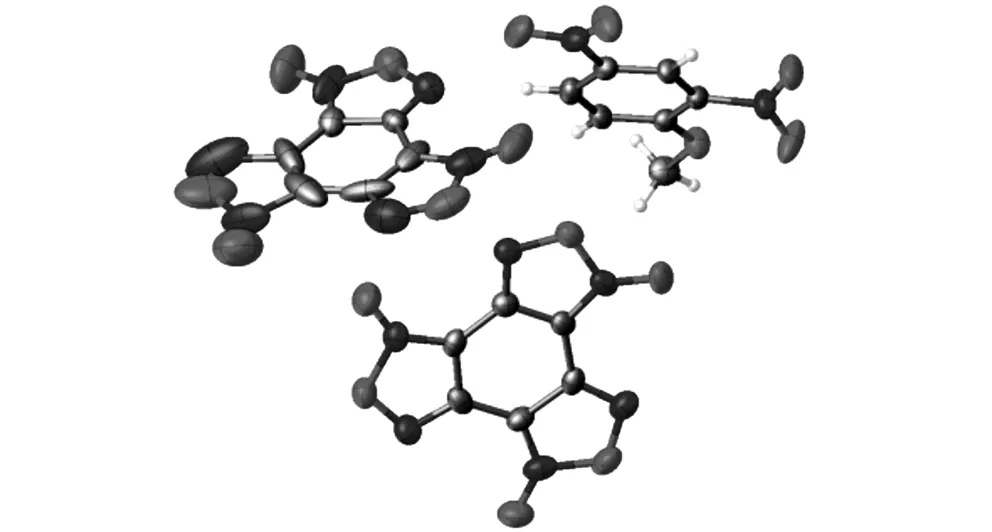Preparation and Performance of BTF-DNAN Cocrystal Explosive
MA Yuan, HAO Shi-long, LI Hong-zhen, LIU Yu-cun, YANG Zong-wei
(1. Institute of Chemical Materials, China Academy of Engineering Physics, Mianyang 621999, China; 2. College of Chemical Engineering and Environment, North University of China, Tuaiyuan 030051, China)
1 Introduction
Energetic materials (Ems) are widely used in military and civilian applications such as the weapons, aerospace explorations and fireworks. However, the inherent safety-power contradiction of existing explosives remains a long-standing problem in the EM field, which limits their practical use.
For a long time,the modifications of existing explosives have often focused mainly on recrystallizing with solution and coating with polymer in order to obtain EMs with lower sensitivity[1-4]. However, these traditional methods can′t markedly reduce the sensitivities of existing explosives with only modifying morphology or diluting power due to unchanging the inherent structures of explosive molecules. Recently, the co-crystallization has received a great deal of attention as a potential method of modifying the properties of existing EMs. The physicochemical properties, safety and detonation properties of HMX (octahydro-1,3,5,7-tetranitro-1,3,5,7-tetrazocine), 2,4,6,8,10,12-hexanitrohexaazaisowurtz-Itane (CL-20) and BTF were changed by co-crystallization[5-10]. In our previous work, CL-20/TNT (2,4,6-trinitrotoluene) and CL-20/DNB (1,3-dinitrobenzene )cocrystals were obtained with good comprehensive properties[11-12]. Results indicate that co-crystallization offers a new opportunity to modify the performances of EMs, since it can endow co-crystals with unique structures and novel properties relative to their pure components. In order to fatherly seek for other co-crystal explosives, the benzotrifuroxan (BTF)/2,4-dinitroanisole (DNAN) cocrystal was studied in this work.
2 Preparation and Characterization of Cocrystals
BTF in Scheme 1 is an important hydrogen-free explosive, belonging to furazan class with high nitrogen content. It possesses high density and excellent detonation performance with high detonation velocity and detonation pressure. But it is sensitive to impact and friction. Besides, it has a difficulty in charge due to its poor flowability and low bulk density. These mainly drawbacks have limited its further application in insensitive ammunitions. On the contrary, DNAN in Scheme 1 has low density, low melting point and poor detonation performance. But it features low sensitivity to impact or friction and low production cost. It is widely used in melt-cast explosives as melt cast binders. Therefore, co-crystallization BTF with DNAN may hopefully tune their safety-power properties and put insights into cocrystal explosive design. In this work, we present a novel energetic-energetic cocrystal composed of BTF and DNAN in a 2∶1 molar ratio. The structure, safety and detonation performance of the cocrystal were studied as well.

Scheme 1 Molecular structures of BTF and DNAN
The BTF-DNAN cocrystal was prepared by cocrystallization from saturated organic solutions through slow evaporation solvents such as ethanol, methanol. The cocrystal obtained from ethanol in good flowability presents prisms with integrated crystal surfaces (see in Fig.1). And it can be easily distinguished from pure BTF and DNAN by their different morphologies. Additionally, according to the experiment, we found the cocrystals grown from ethanol solution with high quality.
Powder X-ray diffraction (PXRD) patterns of the BTF-DNAN cocrystal and pure components are presented in Fig.2. It can be observed that the PXRD pattern of the cocrystal is evidently different from those of pure BTF and DNAN, indicating a new crystalline phases. Moreover, the melting point of the cocrystal is 132 ℃ (confirmed by a Buchi-545 melting point analyzer), which is substantially higher than that of pure DNAN (95 ℃, measured by a Buchi-545 Melting Point analyzer), but obviously lower than that of pure BTF (197 ℃, measured by a Buchi-545 Melting Point analyzer), suggesting that drastically altered melting points can be achieved by co-crystallization.
The single crystal X-ray diffraction (SXRD) analysis of the BTF-DNAN cocrystal confirms that it belongs to monoclinic system withP21/cspace group, and as shown in Fig. 3, its asymmetric unit consists of two BTF molecules and one DNAN molecule.

a. BTF b. DNAN c. BTF-DNAN cocrystal
Fig.1 SEM images for BTF, DNAN and BTF-DNAN cocrystal

Fig.2 PXRD patterns for BTF, DNAN and BTF-DNAN cocrystal

Fig.3 Molecular structure of BTF/DNAN cocrystal
Crystal structure analysis shows that BTF and DNAN molecules are mainly stacked by lots of CH…N hydrogen bonds between the H(C) atom of the DNAN molecule and a nitrogen atom of the BTF molecule. Distances in the observed range are within the region for hydrogen bonds of this type. Besides, π interaction lies between an electron-rich nitro group of the DNAN molecule and the big electron-poor ring of the BTF molecule. As a result, these intermolecular interactions promote BTF-DNAN cocrystal formation.
The impact sensitivity of each test sample was expressed by the drop height of 50% explosion probability (H50) according to GJB-772A-1997 standard method 601.2. AnH50of 34 cm, was measured for pure BTF while the BTF-DNAN cocrystal presents anH50of above 112 cm, which is more than three times of the pure BTF, indicating that cocrystal displays enhanced safety to impact compared with pure BTF. Moreover, the sensitivity of pure BTF was substantially reduced by co-crystallizing with insensitive DNAN, potentially promoting the applications for BTF in insensitive munitions. Through co-crystallization, therefore, it is possible to tune performances of existing EMs and achieve higher density explosives with enhanced properties.
3 Conclusions
We have prepared and characterized a novel furazan-aromatic cocrystal explosive composed BTF and DNAN in a 2∶1 molar ratio. This cocrystal was formed by unique C—H…N hydrogen bonds, and π interactions, foreseeing that some of new cocrystal explosives stacked by the similar intermolecular interactions may be discovered in future. The alterations in structure ultimately produce unique properties in the cocrystal, with respect to the pure components. In particular, BTF-DNAN cocrystal features lower sensitivity to impact relative to pure BTF. Our investigations on the energetic-energetic cocrystal of the BTF-DNAN provide a promising way to tune properties of the existing explosives.
Acknowledgement:We gratefully acknowledge the support for this study by the Natural Science Foundation of China (No.11402236).
[1] KrÖber H, Teipel U. Crystallization of insensitive HMX[J].Propellants,Explosives,Pyrotechnics, 2008, 33(1): 33-36.
[2] CHEN H X, Li L J, Jin S H, et al. Effects of additives on ε-HNIW crystal morphology and impact sensitivity[J].Propellants,Explosives,Pyrotechnics, 2012, 37(1): 77-82.
[3] Kasprzyk D J, Bell D A. Characterization of a slurry process used to make a plastic-bonded explosive[J].Propellants,Explosives,Pyrotechnics, 1999, 24(6): 333-338.
[4] Elbeih A, Pachman J, Trzciński W A, et al. Study of plastic explosives based on attractive cyclic nitramines part I. detonation characteristics of explosives with PIB binder[J].Propellants,Explosives,Pyrotechnics, 2011, 36(5): 433-438.
[5] Landenberger K B, Matzger A J, Cocrystal engineering of prototype energetic material: surpermolecular chemistry of 2,4,6-trinitrotoluene[J].CrystalGrowth&Design, 2010, 10(12): 5341-5347.
[6] Landenberger K B, Matzger A J. 1,3,5,7-tetrranitro-1,3,5,7-tetrazacyclooctane(HMX)[J].CrystalGrowth&Design, 2012, 12(7): 3603-3609.
[7] Bolton O, Matzger A J. Improved stability and smart-material functionality realized in an energy cocrystal[J].AngewandteChemieInternationalEdition, 2011, 50(38): 8960-8963.
[8] Bolton O, Simke L R, Pagoria P F, et al. High power explosive with good sensitivity: a 2∶1 cocrystal of CL-20∶HMX[J].CrystalGrowth&Design, 2012, 12(9): 4311-4314.
[9] Yang Z W, Li H Z, Zhou X Q, et al. Characterization and properties of a novel energetic-energetic cocrystal explosive composed of HNIW and BTF[J].CrystalGrowth&Design, 2012, 12(2): 5155-5158.
[10] Zhang H B, Guo C Y, Wang X C, et al. Five energetic cocrystals of BTF by intermolecular hydrogen bond and π-stacking interactions[J].CrystalGrowth&Design, 2013, 13(2): 679-687.
[11] Wang Y P, Yang Z W, Li H Z, et al. A Novel Cocrystal Explosive of HNIW with Good Comprehensive Properties[J].Propellants,Explosives,Pyrotechnics, 2014, 39(5): 590-596.
[12] YANG Zong-wei, ZHANG Yan-li, LI Hong-zhen, et al. Preparation, structure and properties of CL-20/TNT cocrystal[J].ChineseJournalofEnergeticMaterials(HannengCailiao), 2012, 20(6): 674-679.
- 含能材料的其它文章
- Synthesis and Characterization of Two New Energetic Polyamino and Nitro Pyridine Derivatives
- 《含能材料》2015年(第23卷)总目次
- Non-isothermal Decomposition Kinetics,Specific Heat Capacity and Adiabatic Time-to-explosion of Cu(pn)2(FOX-7)2
- Facile Synthesis and Crystal Structure of 3,4-Bis(1H-5-tetrazolyl)furoxan
- Synthesis and Properties of N,N-Bis((3,5-dinitro-1H-1,2,4-triazol-1-yl)methyl) nitramine
- Comparison with Molecular Surface Electrostatic Potential and Thermal Reactivity of Nitramines

